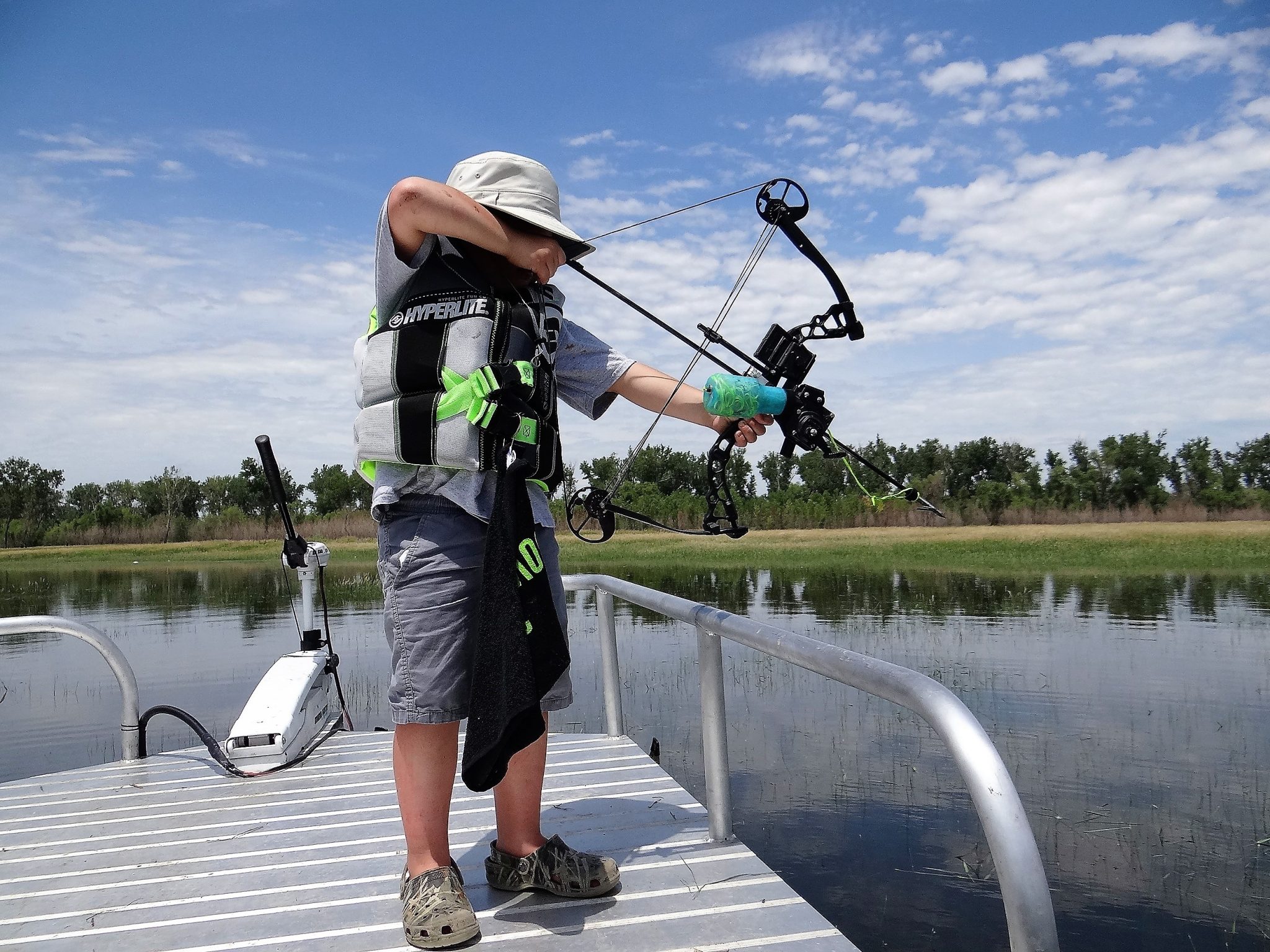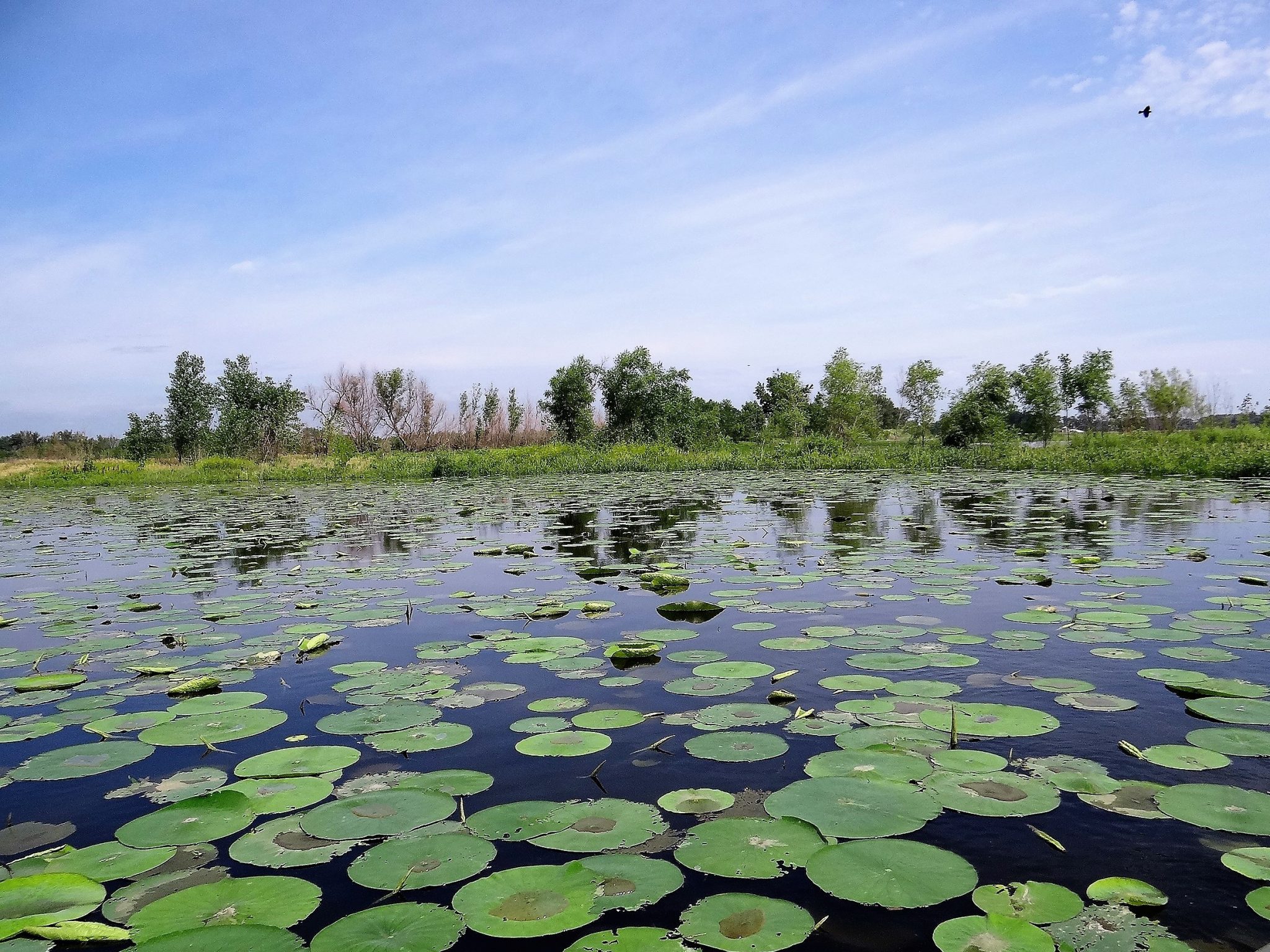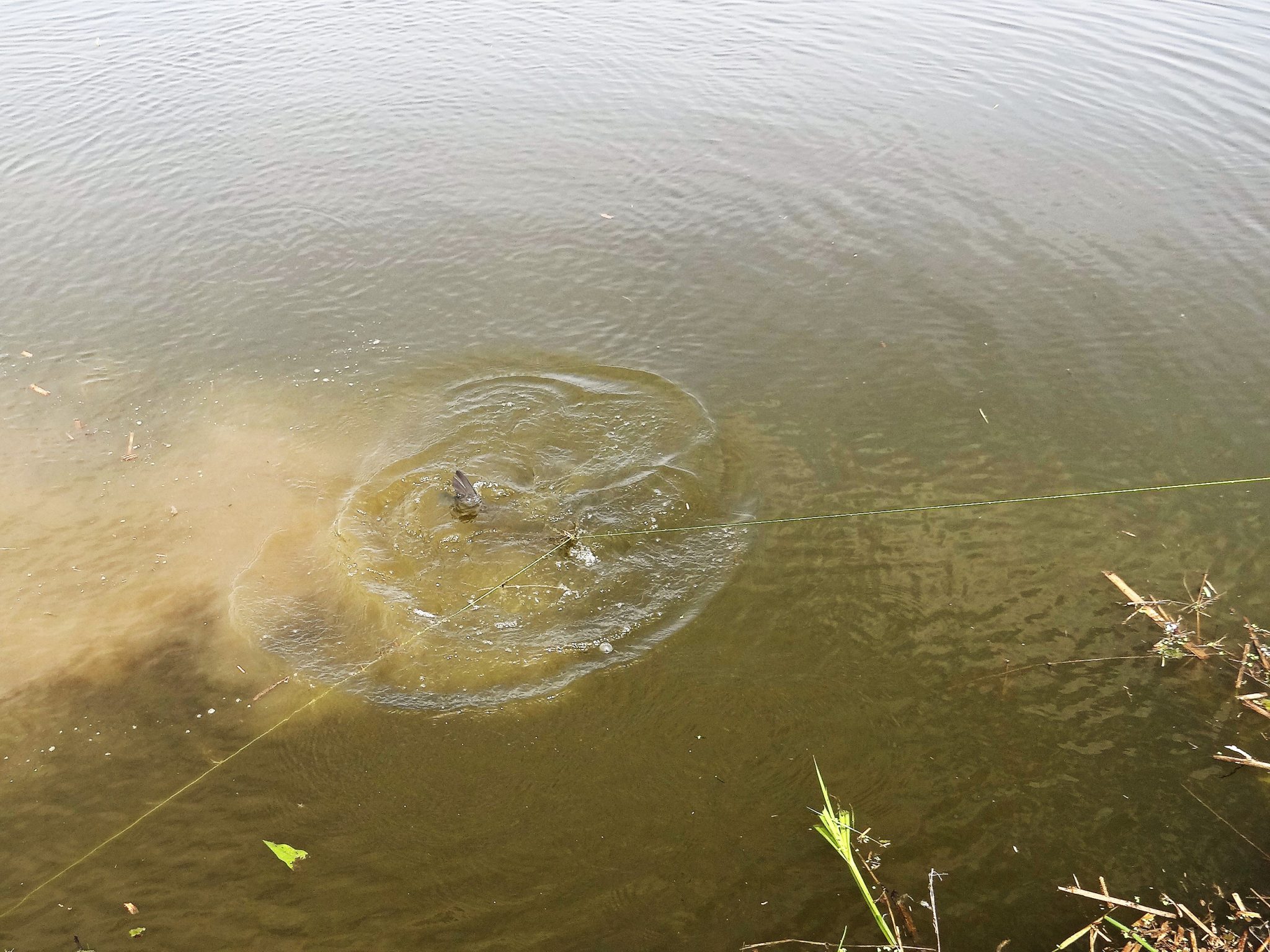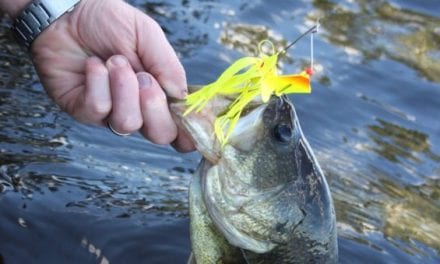Zac Hickle is an avid fisherman. He could take a rod and reel, tackle box and bait, and sit by the river’s edge to try to catch catfish and a variety of other fish. But, he doesn’t do that.
Instead, at home he gets his young 6-year old son, Gavin, ready, then hitches up his customized Jon boat loaded with archery fishing gear, life jackets and large tubs, and sets off for the backwaters of mighty Missouri River.
You see, Zac Hickle of Elkhorn, NE is a hardcore bowfisherman. I mean, really hardcore.

In fact, he doesn’t even bow hunt for big game animals. His target is nongame fish. He and his son are primarily after Asian carp family members – Silver carp, bighead carp and grass carp as well as common carp and mirror carp. Gar and buffalo are a popular targets, too.

It is not uncommon for Hickle and his son to shoot more than 500 pounds of nongame fish in a single trip.
Zac credits his stepdad, whom he refers to as “Dad,” with introducing him to fishing and fostering his love and appreciation for it. Hickle, who also rod-and-reel fishes and turkey hunts, is passing along the fun and passion of bowfishing to his son.


Hickle says, “Bowfishing is unlike anything else in the outdoor world, and it can be anything you want it to be.”

On a recent bowfishing expedition for nongame fish on the Missouri River with Zac, Gavin and off-duty Nebraska conservation officer, Rich Berggren, I can vouch for the fact that bowfishing is a highly addicting, unique outdoor lifestyle. It had been some 40 years since I knocked an arrow for fish on the water, so I guess you could call me an old beginner. And, even though sore muscles were felt for several days after flinging and retrieving numerous arrows at many fish, I cannot wait to get back on that big river to bowfish again.

Few things, it seems, are as adventurous!
Popularity
Whether its the appeal of archery as a whole or the excessive and growing number of invasive fish species such as Asian carp, bowfishing has grown in popularity significantly.
Men, women and children of various ages are gearing up for bowfishing excitement on rivers, creeks, lakes, reservoirs and ponds, taking part in both recreational outings and major competitions.
Examples of bowfishing’s growth can be seen in equipment sales and the national association that promotes it.
Executives at the Muzzy Corporation which manufactures broadheads, bowfishing reels and other archery products, have witnessed bowfishing go from a tiny part of their business to one that now comprises about 25% or more of their overall sales. Muzzy, considered a pioneer in the archery fishing industry, now sponsors big time bowfishing tournaments.
Take the Bowfishing Association of America as another example. Established in 1990 to originally help organize and track bowfishing tournaments around the country, its founders saw membership go from around 500 in 2005 to approximately 4,000 in 2017. Today the association works to fervantly encourage bowfishing involvement, maintain trophy records, and provide support to clubs and regional bowfishing groups. Regional clubs and state-level fishing organizations continue to spring up across the U.S. and recruitment is at an all-time high.
Bowfishing also appears to be growing increasingly popular among both hunters and regular anglers. More bowfishing tournaments are held annually in the United States and Canada, and the activity isn’t limited to North America either. Bowfishing forums and social media sites abound on the Internet, and outdoor guides offer bowfishing trips in the United States, Canada, Australia, New Zealand and other countries.
In Nebraska, for instance, a recent bowfishing tournament on nongame fish (mainly common carp) at Lake McConaughy near Ogallala, NE drew a record number on participants.
But let’s go deeper.
What’s really behind the growth in the popularity of bowfishing?
Having done it, I think the answer may be fairly simple.
This outdoor lifestyle is flat out “fun.” It provides literally non-stop, fast-paced action, requires little monetary investment and is an excellent way for bowhunters to stay sharp with their skills and keep shooting throughout the spring and summer months at considerable numbers of nongame fish, most notably Asian carp.

Bowfishing also gives a person an opportunity to explore the wilds of backwater and wetland habitats.

These contain a wide variety of interesting wildlife species to see from reptiles and amphibians to furbearing mammals to waterfowl and other birds.

Unlike archery deer hunting or hook-and-line fishing, bowfishing does not mandate that you to sit still and remain quiet either. Actually it’s an incredibly social sport, often taking place on a moving boat with much conversation. Some moments are slow, but, I will tell you they can quickly give way to moments of mayhem and thrill when a large school of silver carp are swimming and jumping everywhere!
The Equipment
Bowfishing is easy and can be done by anyone interested in learning a new outdoor lifestyle.
Basically, all that is necessary to start your basic bowfishing adventure is a bow, an arrow and some string.
Any type of bow can be used from a recurve to a compound bow and there are now a several different brands of reels, loaded with heavy test line, that can be attached to the bow making harvesting fish quicker and uncomplicated. The arrow needs to be specifically made for bowfishing by having one point that is barbed at the tip in order hold on to a fish after it has been shot. There are various styles of arrows that can be used but the basic carp point can be used to shoot any type of fish.
There are specifically produced compound bows for bowfishing, but if you have an older compound hunting bow lying around, you can buy a bowfishing conversion kit for it with a reel, line and a few arrows in expensively. There are even complete starter kits for bowfishing in the marketplace.
Bowfishing can be done from the bank or boat, or with waders or rubber boots. There are an array of boats that are utilized for bowfishing varying from high-powered airboats and jet boats to custom-built Jon boats.

Aim Low
It has been said that refraction is the bane of bowfishers. This is the way water “bends” light waves, and it makes a fish appear where it is not. And the deeper a fish holds in the water column, the more refraction comes into play.
What this means is that an archer must aim well below where he sees a fish in order to hit it with his arrow. In the case of a fish down four or five feet, an arrow must be aimed two feet or more below the fish to strike it.

Refraction of light waves makes a fish appear higher in the water column than it actually is. And that makes successful bowfishing all the more difficult, and rewarding when archers succeed.
Here are a few guidelines that successful, longtime bowfishermen use to help them compensate for refraction in the water:
– The 10-4 rule: If the fish is 10 feet (3 meters) away and 1 foot (30 centimeters) below the surface, then aim 4 inches (10 centimeters) low. If you double either the 10 or the one, then double the four. For example, you would aim 8 inches (20 centimeters) low for a fish that’s either 20 feet (6 meters) away and 1 foot deep or 10 feet away and 2 feet (60 centimeters) deep.
– Aim about 6 inches (15 centimeters) low for every 1 foot of depth.
– Look at the fish and aim 10 inches (25 centimeters) low.
– Water is dense and slows arrows down; the less water that your arrow has to traverse, the more force it will have when it strikes the target.
When you shoot at a fish, try to aim for the front half of it. This portion contains the brain and vital organs, so you will most likely kill the fish humanely and not have to dispatch it with a small club on the bank or in the boat. In the heat of summer, when the flesh of fish tends to be softer, Hickle prefers to shoot fish in the hard gill plate so as not to have them break off in the water. Furthermore, we need to remember that fish can swim quite fast, so you don’t have much time to draw and shoot. Also, some large fish, like big gar, may take another arrow to get or kill them. This is called a double-tap. Once you’ve struck the fish, haul in the line.

The Porter Method for Cooking Asian Carp
In an interview with Omaha Magazine a while back, ardent bowfisherman whom many consider “The Godfather of Bowfishing,” Rich Porter of Omaha, NE, relayed a unique cooking method for Asian carp using a dishwashing machine to poach fillets (yes, a dishwasher).
In the magazine, Porter suggests taking a fillet of Asian carp, wrapping it in aluminum foil with your favorite seasonings and butter, then placing it on the top rack of an empty dishwasher and running a full cycle with no soap. Believe it or not, some folks have even tried it while doing their dishes; again, with no soap. When you remove it the carp meat flakes off the bone and can be used in fish tacos, fish sandwiches, or used in crab cake dishes. Porter says, “Once you poach it, you can use the meat for any recipe that calls for fish. Blackened fish tacos are my favorite.”
When cooked, the meat of bighead, silver and grass carp is firm, very mild and slightly sweet. It readily absorbs spices and marinades, but is also superb when used in a classic fish fry. The meat tastes sort of like a cross between scallops and crab meat. Large bighead carp are preferred by most archers at the cleaning table and at the supper table.

Other Key Tips
*Scout and explore your bowfishing areas. Do not be afraid to hop online, use handy mobile apps, pull up maps and check river flows and levels. Best success in the Missouri River backwaters occurs when the river is rising and remains high.
*To spot fish in the water shoot with your bow, look for lips, fins, scales and shadows. Be aware of your own shadow when you are getting ready to shoot, too, because it can spook the fish. Grass carp and gar are extremely wary.
*Plan to be on the move and cover a lot of water, you will be more successful than staying in one spot.
*While bowfishing does not require a boat, it is generally better to fish from a boat outfitted with a bowfishing deck and lights.
*How heavy of line should be spooled on bowfishing reels? Zac Hickle employs 200-pound braided test line.
*Bowfishing is similar to shotgun shooting. Don’t aim. You need to point and shoot instinctively in an unhesitating matter. In fact, there are no sights on most fishing bows anyway.
*Snap shooting is a effective skill to learn for bowfishing. Snap shooting is when you draw your bow back part of the way and release the arrow without coming to full draw.
*According to Zac Hickle, the top archers in bowfishing have about 50 percent shooting success. Newbies in the lifestyle (such as your blogger and a conservation officer friend) typically log about 10 to 15 percent success. The bottom line is don’t get frustrated in bowfishing, just keep shooting!
*Polarized sunglasses are an absolute must to bowfish in the daytime. They help cut glare from the sky’s reflection in order to better see fish in the water. A ball cap or wide-brimmed hat should be worn as well.
*What else to wear, bring or pack for a summer bowfishing outing? The list might include a myriad of items such as: Old clothes (loose-fitting, lighter colors), Crocs or river sandals, sunscreen or sun block, insect repellent, a towel, as well as plenty of cold water, snacks or sandwiches put in a small ice-packed cooler. Additional items may include a comfortable U.S. Coast Guard-approved life jacket that fits (unless one is provided), plus a compact first aid kit, rain jacket and a Smartphone, iPhone or camera placed in a waterproof dry bag.

*For some archers, fishing gloves are essential as fish can be slimy and some fish like gar have sharp teeth.
*Typically, you’ll be bowfishing in relatively clear, shallow water areas of around 4-6 inches in depth up to about 4-5 feet deep.

* Look for newly flooded areas of green grass or vegetation.

*You will end up getting your arrow stuck in the muddy bottom of backwaters. Be aware of that. Your boat operator will assist you in getting it unstuck.
*Respect each others’ shooting lanes and space on the deck of a boat.
*Nice, clear weather with calm winds and high sun is a great time to go bowfishing. Archers can shoot fish on cloudy days, but the fish usually see you before you see them! Bowfishing is also done at night with bright artificial lights but with courtesy given to cabin dwellers and campers near the shoreline. Cooler nighttime hours in the heat of summer can be outstanding for bowfishing.
*Particularly with a boat, you can herd Asian carp like cattle. Push them slowly toward the end of a narrow backwater finger or canal, the carp will scatter in all directions in the grassy shallows. Cautiously closing the distance is the deciding factor to getting shots, but fish can appear and disappear from anywhere in the water at any time. The action can be crazy and quite unpredictable to say the least!
*”You shoot it, you own it,” stresses Zac Hickle. Eat the fish, give it away, use it as natural garden fertilizer, compost, food for your livestock (hogs) or pets (dogs) or furbearer animal trapping bait. Bowfishers occupy an important role in conservation helping to remove and utilize large numbers of invasive Asian carp from infested Nebraska waters.

*Connect with archers who enjoy the bowfishing lifestyle by joining a great, local public bowfishing group on Facebook — Bowfishers of Nebraska.
Rules and Regulations
Julie Geiser, experienced archer and public information officer for the Nebraska Game and Parks Commission based in North Platte, reminds us of the legal requirements for bowfishing in Nebraska. She offers this synopsis.
There are some rules and regulations that must be followed for bowfishing, just like any other outdoor sport or activity. First and foremost, a current, valid Nebraska fishing permit is required to bowfish in the Cornhusker State’s waters. Game fish may be taken with archery statewide from July 1 through Dec. 31 from sunrise to sunset. Nongame fish may be taken by archers statewide 24 hours-a-day, year-round. Artificial lights are allowed. Special regulations and permit apply to archery paddlefish shooting in a designated portion of the Missouri River in northeast Nebraska.
Legal archery equipment is hand-drawn only, which includes long bows, compound bows and crossbows. Arrows may have only one point, which must be barbed, and have to be attached by a line to the bow at the time the arrow is released.
Anglers must know the length limits on game fish before letting an arrow go, which can be tricky, so positively identify the target and know how to evaluate its size. All game fish laws and regulations apply to bowfishing. And for those of you that shoot carp or other nongame species, they cannot be discarded or just “thrown” on the bank and left to die. The fish must be utilized in some way, shape or form. Killing them and throwing them back into the water is also illegal.
Before venturing onto any private land to bowfish, permission from the owner must be acquired. In addition, bowfishers with boats need to double-check boating requirements prior to launching their vessels for the year.
More information on Nebraska fishing and boating laws/regulations can be obtained on the Game and Parks Commission’s website.
As with any shooting sport or water-related activity please keep safety in mind at all times.
Youth and Bowfishing
Bowfishing is tailor made for young folks.
It doesn’t require long sits, remaining quiet or high-level skill that pursuing white-tailed deer with archery equipment necessitates. It’s more of an active, leisure activity and in one trip, you can expect to have a lot of shot opportunities. The look on a child’s face when they are finally able to connect or double tap with a moving target is truly priceless.
But, how does a youngster learn about bowfishing?
Enter the Nebraska Bow Fishing Mentor Program.
It was established by volunteer organizer Nick Tramp of Allen, NE.
The mentorship program will enter its sixth consecutive year in the spring of 2019. Tramp, Hickle, Porter and other Bowfishers of Nebraska volunteers serve as instructors and take youngsters of varying ages, along with a parent or guardian, to pre-selected public locations to shoot nongame fish with archery equipment following a classroom session.
These free programs, hosted by the Bow Fishers of Nebraska, allow youth to explore the challenge and excitement of harvesting fish with archery gear. They will learn about equipment, safety, regulations, ethics and care for harvested fish, and will shoot from both the shore and a boat. Youth must be at least 10 years old to attend. No experience is needed, and nearly all of the equipment is provided.
Space is limited, and registration will required online through the Nebraska Game and Parks Commission to save a spot when the time approaches.
Zac Hickle puts taking youth bowfishing in perspective. On his Facebook page, he writes: “Most people don’t discover fishing, it’s a gift that’s given to them. Do your part, take a kid fishing.”

The post Go Bowfishing: Aim Low, Think Big, Shoot Often, Have Fun! appeared first on NEBRASKALand Magazine.
















